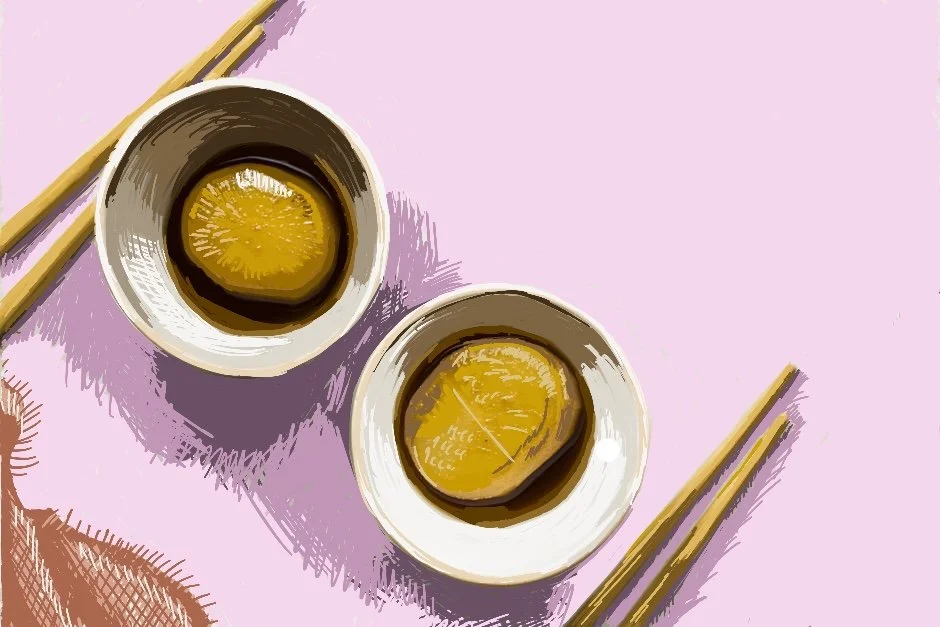Daikon no nimono
Slowly simmered, daikon soaks up umami flavours and turns into something beautiful
DAIKON NO NIMONO
SERVES 4 | PREP TIME: 10 minutes | COOK TIME: 1 ¼ hours
The Japanese really nail comfort food with nimono preparations – that’s simmered dishes, generally vegetable or protein cooked in shiru – stock, often dashi-based with additional oomph from soy sauce, sake, and a little sweetening from sugar or mirin.
Cooking daikon in this way, with the vegetable kept in satisfyingly large pieces, ensures every bite is juicy and bursting with umami flavour. Thanks to my friend and amazing cook Kyoko Meguro, for teaching me to cook this in her tiny kitchen.
INGREDIENTS
1 medium daikon (around 600g)
2 litres starchy water from washing rice (see notes)
1–1½ litres water
1 4x4cm piece dried kombu, wiped clean of salt residue
1 tsp hondashi
3 tbsp soy sauce
2 tsp sugar
1 tbsp cooking sake
2 tbsp mirin
Crisp pork mince topping (optional)
200g fatty pork mince
1 tbsp cooking sake
1 tbsp soy sauce
2 tsp red miso paste
1 tbsp sugar
1 tsp oyster sauce
METHOD
Prep the daikon, removing the sprouting end and peeling off the skin. Slice the daikon into discs around 4cm thick. Prep each disc by first slicing off the hard, light green layer around the perimeter, then mentori the edges of each piece so you end up with nice curved discs (see notes). Using the tip of the knife, make a shallow kakushi bocho x-incision on one face of each piece (see notes).
Arrange daikon slices in a large pot in level layers. Cover with rice water and bring to boil, then reduce to a fast simmer and cook for 15 minutes skimming the foam off the surface as it cooks. Gently drain and rinse daikon, then return daikon to the cleaned pot in level layers, and add around 1 litre of water or just enough to cover. Add the rest of the ingredients except the mirin and bring to a fast simmer. Turn down to a gentle simmer and cook with the lid on for 60 minutes or so. Check liquid level during cooking and top up with a little boiling water if necessary, to keep the liquid just below the top daikon pieces.
Once daikon is tender, add mirin to the pot, turn heat up to a medium simmer, and cook for another 5 minutes. The daikon should obtain a glossy appearance towards the end of the cook time, then it’s ready. You can serve right away, or better yet as Kyoko recommends, make ahead of time and cool the daikon in the pot, then reheat to serve. The flavours will be more concentrated this way.
To make crisp pork mince topping, heat a little vegetable oil in a small frying pan and once shimmering, add the pork mince, breaking it up with a wooden spoon. Brown the mince all over for 4 minutes or so. Combine the remaining ingredients in a small bowl then add to the mince. Stir fry on high heat for 4 minutes or so until the sauce is reduced and the mince is crisp.
Serve in small bowls, one slice of daikon at a time with a small amount of broth, not quite enough to cover the daikon. If topping with crisp pork mince add it after the broth, placing a tablespoon or so of the mince on top of the daikon slice. Served with steamed shortgrain rice.
NOTES
Two bits of knife work make a big difference to this dish. Mentori is the rounding off of edges and corners of vegetables for simmered dishes – akin to the chef technique we know as ‘turning’ vegetables, but in this case it’s not so much aesthetic but more practical: planing the edge off the discs of daikon prevents the slices from breaking up on the fragile edges during cooking. Kakushi bocho, meaning ‘secret knife’, refers here to making a cross incision in the face of each daikon slice to hasten the saturation of the vegetable with flavoursome stock.
As this dish would usually be served alongside steamed short-grain rice, make use of the starchy water drained from washing the rice – capture it and use it for a first simmer of the daikon; this helps neutralise any bitter taste and the smell.
Kombu and hondashi (instant dashi powder) can be bought at Japanmart, while the remaining specialty ingredients are found at most good supermarkets.

